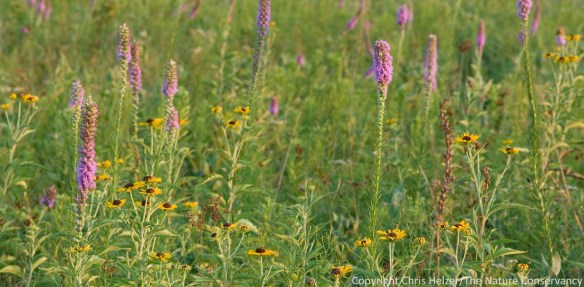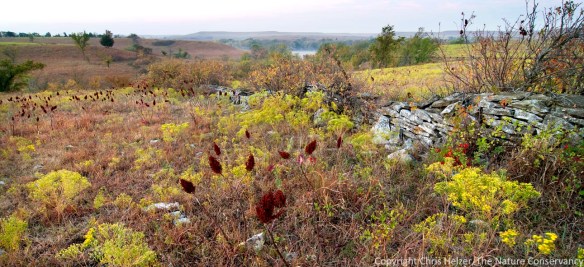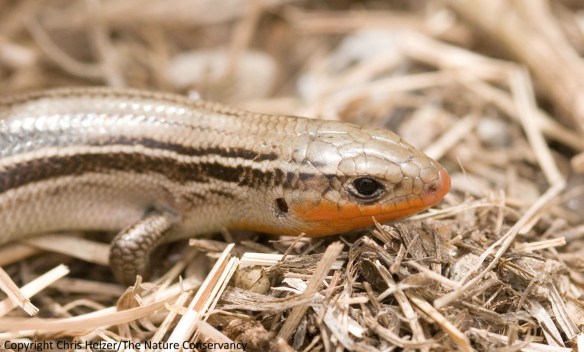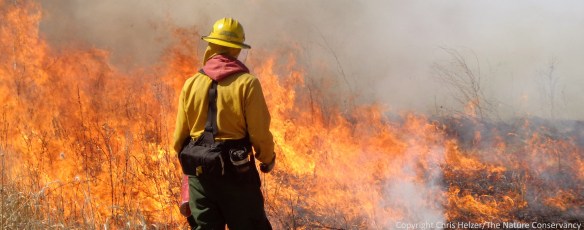HOW OFTEN SHOULD PRAIRIES BE BURNED?
It’s a question prairie ecologists and managers have been wrestling with for many years. Unfortunately, research on the impacts of fire management is somewhat limited and often contradictory. Much of the best research has come from Konza Prairie in the flint hills of eastern Kansas, but many have rightly pointed out that translating flint hills research to other prairies – especially eastern tallgrass prairies – can be tricky.
At Konza and other western tallgrass prairie sites, frequent application of fire (in the absence of grazing) tends to increase the dominance of grasses, and decrease the abundance and diversity of wildflowers. However, prairie ecologists and managers working in eastern tallgrass prairies (particularly in Wisconsin and Illinois) point to numerous prairies that have been frequently burned for decades with no apparent loss of plant diversity. Those experts make strong arguments against applying western experience with frequent fire to eastern prairies. Unfortunately, the discussion has suffered from a scarcity of published long-term data from eastern prairies to help evaluate impacts of fire management there.
Just last month, an excellent research paper by Marlin Bowles and Michael Jones helped fill that void. In 2001, Bowles inventoried the plant communities of 34 prairies around Chicago, Illinois – ranging from dry to wet-mesic sites – and compared those data to similar inventories conducted twenty five years earlier. The similarity in sampling methods between the two efforts allowed Bowles and Jones to look at how fire frequency affected changes in plant species composition over a significant period of time. In short, they found that a high fire frequency had a positive correlation with plant diversity.
Using data from a series of 0.25m2 plots, Bowles and Jones analyzed changes in the average number of plant species (species richness) between the 1976 and 2001 data sets. Frequent burning increased species richness overall, but had a particularly positive impact on summer wildflower richness. Spring wildflowers, warm-season grasses, and legumes didn’t necessarily increase in species richness with higher fire frequency, but strongly decreased in richness within prairies that were not burned very often. The authors speculated that the greatest impact of burning on plant species richness was likely the removal of detritus (previous years’ vegetation), which can greatly reduce the amount of light available to growing plants and also change microclimatic conditions and nutrient availability. Because eastern tallgrass prairies receive more rainfall than do western prairies, they produce more plant biomass each year. Bowles and Jones pointed to that increased biomass production as a probable reason that frequent fires have such a strong positive impact on plant diversity in eastern prairies.

In the eastern tallgrass prairies studied by Bowles and Jones, summer wildflower diversity increased under frequent burning. (Photo from Taberville Prairie – Missouri)
The contrast in response to frequent fire between western and eastern tallgrass prairies is intriguing, and it’s great to have published long-term data to help quantify it. It may be that increased vegetative growth due to higher rainfall in the east is largely responsible for the difference, but surely the story is more complicated than that. It will probably take quite a bit more research across the entire east-west continuum of tallgrass prairies before we really understand what’s going on.
In the meantime, it’s important to recognize differences in the way eastern and western tallgrass prairies respond to fire management, but it’s also important to not overly generalize those results. Every prairie will still respond individually to management (based on many factors, including soil type, presence/abundance of invasive species, etc.,) and it’s important not to implement any management regime without evaluating and adjusting over time. In addition, east vs. west is only one of many ways to characterize differences between prairies and their responses to management. Northern and southern prairies, for example, also respond very differently to management – due in part to a stronger cool-season grass component in northern prairies, including several invasive grasses which are really not a factor in the ecology of southern prairies. (Southern prairies have their own set of invasive species as well.)

Prairies like this one in the flint hills of Kansas respond differently to fire and other management treatments than do prairies further east. However, other variables (latitude, soil type, topography, land use history, and more) all influence management responses as well.
.
BUT BE CAREFUL…
While I thought the paper by Bowles and Jones was very well done, two thoughts occurred to me as I read it. I will deal with each only briefly now, but will flesh them out more in future posts. I think both are important to consider before entering into a management regime dominated by frequent burning.
First, Bowles and Jones emphasized the importance of frequent fire as a “stabilizing force” in tallgrass prairie plant communities. In other words, they inferred that good management should result in a plant community that changes little from year to year. They called these stable plant communities “late-successional,” a term that I have a difficult time applying to prairies, which require frequent disturbances to keep from becoming woodlands. Regardless of terminology, however, the question of whether or not prairies should have stable plant communities is an interesting one. I’ve argued in the past that healthy prairie plant communities should look different each year (see, for example, my post on “Calendar Prairies”.) However, most of my experience comes from more western prairies, so I have an admitted bias. Still, it worries me to have a management regime that always favors the same species year after year, because other species are – by default – being perennially managed against. Reducing the overall pool of species in a prairie seems potentially risky, but I don’t know how serious that risk might be.

These black-eyed susans are blooming in profusion the year after a Platte River Prairie was grazed. An abundance of short-lived opportunistic species such as this one might lead to a prairie being characterized by som as “mid-successional”. Whether or not that characterization is apt or useful is an interesting question, and may depend upon where a prairie is located (or may just depend upon the background of the ecologist thinking about it!)
Second (but related to the first), arguments for frequent fire tend to focus primarily on plant diversity rather than the overall diversity of the prairie community, including both vertebrate and invertebrate animals – not to mention fungi, bacteria, and other organisms. Fire can have serious negative implications for some of those other residents, especially when small isolated prairies are burned in their entirety, leaving no unburned refuges for vulnerable species. Insects that overwinter in the stems of plants, for example, are particularly vulnerable to spring fires. The dramatic change to habitat structure wrought by fire can also have big impacts on vertebrates (as well as invertebrates) that require thatchy cover for survival. As I mentioned above, reducing the pool of species in a prairie (plant, animal, or otherwise) may have serious implications for the overall health of the prairie – especially in fragmented landscapes where species are unlikely to recolonize areas from which they are eliminated.

I generally find prairie skinks such as this one in prairies with a certain amount of thatch. I’m not sure how this or other thatch-dependent species would do in frequently burned prairies.
I tend to favor prairie management that provides multiple habitat types and growing conditions each year, and shifts the locations of those around the prairie from year to year. That kind of mixed and dynamic management should help ensure that animal species can always find a place to live within a prairie, and that every plant species will have positive growing conditions at least every few years. However, I’m making some big assumptions about the importance of that philosophy, and I’m certainly not advocating that every prairie should be managed that way – especially very small prairies for which subdivision of management may not even be feasible.
UPSHOT
Saying that prairies are incredibly complex and difficult to understand is an understatement. I think our prairie management should account for that complexity. Good managers carefully evaluate the responses of their prairies to management, and adjust accordingly. The Bowles and Jones study helps us better understand the way prairies respond to management, but also highlights the danger of simply applying what works in some prairies to others. Their paper focuses on differences between east and west, but regardless of geographic location, soil type, size, or degree of isolation, every prairie needs (and deserves!) management that is custom tailored.


Chris,
Removal of the litter from the previous year is the key for most species. We have learned the lesson of leaving the old dead material from the previous year in our seed production plots the hard way. Disease, pests persist well in the old dead vegetation, but remove it by burning or haying and the disease and pest issues are reduced greatly. I am sure the same happens in a prairie that is not burned or hayed, many of the plants are reduced by the influx of disease and pests. Some species are more susceptible to disease/pests and are removed from the system earlier.
Legumes and fire go hand in hand??? That is one of the ways that legume seed is scarified, by burning. Thus burn years should have greater amounts of legumes, especially small new recruits. The number of flowering plants may not be seen for a couple of years after the fire.
The one thing I can say is that your system of grazing prairie creates more of a patchy burn than a prairie that fire only is utilized. One tool we have used to reduce some of the grass in our reconstructed prairies is spray a grass selective herbicide. This has caused a patchy burn this spring especially with the cool damp spring we are having. I am sure you see the same thing with your areas that have been grazed-patchy burns in the grazed areas. So there is a change in effects with combinations of management.
Stable system is what is great about prairie. It is not seeing the same prairie picture annually, but to have a system that is resilient to change. This could be seen last year with the hot-dry summer we had. The prairie is still there, but some species were greatly reduced, while others flourished. Compass plant, Lead plant, and Round headed bushclover were bountiful during last years hot dry summer. For example, previous to last year only one Compass plant had flowered in our 10 year old reconstruction, last summer we had 25 or more flowering plants.
Thanks for your blog. I try to read it often!
Bill
Thanks Bill – the drought last summer was interesting here too. Definitely nice to see plant species that can step up their game in dry years.
Bill, I have seen forb diversity (including legumes) significantly reduced after a burn. This observation was at a prairie restoration in the Chicago area. My observations paralleled those of researchers at Konza. I will have to look through Mr. Bowles and Mr. Jones paper before I can comment. I think in local remnants higher fire frequency does result in more diversity. I have no explanation for why fire would act differently in a remnant than in a restoration. The answer probably relates to the higher complexity of the biological system in remnants.
James
Upon rereading my previous comment after eight years, I think the reduced diversity I observed after a burn might have just been a lag period. Burning a prairie reconstruction after it has not received fire for a long period tends to allow the warm season grasses to grow vigorously. However, researchers have recorded that with regular frequent burning and time the dominance of warm season grasses in the eastern tall grass region fades. As is often the case, an observation over a short period of time can be found to be general untrue after longer term observations have occurred.
Long term observations require good data keeping. I can remember what a prairie looked like last year, or maybe even two years ago. However, I don’t trust my memory to be accurate regarding what a prairie was doing 15 years ago.
Chris,
As you know I burned our 2010 seeded 1 acre prairie for the first time about a month ago. As I walked it over the weekend I noticed many areas have an abundance of seedlings and my first guess was black-eyed susans. Now after getting down into the low 20’s Saturday morning we’ll see how they do. My short experience shows prairie plants are tougher than I originally thought.
As I was walking the prairie I was wondering if a late fall dormant seeding followed by an early spring burning would be good to add forb diversity? Originally I thought it would be a bad idea to seed the fall before a spring burn, but after seeing all the seedlings I have now and clean ground, thinking it might be a good thing. Ideally the seeds would work into the soil over winter and not be damaged by the fire. What are your thoughts on this?
Mike
You don’t have to worry about toughness in your prairie plants.
The question about whether or not to see prior to a burn is one I’ve had a lot, but have never studied. I don’t know of anyone who’s tested it, which seems silly, so hopefully someone has and I just haven’t heard about it. My GUESS is that most species would come through the fire ok – especially if you seeded in the fall and burned in the spring because – as you said, some of those seeds would get low in the thatch. Probably the fluffier seeds would be the most vulnerable to damage from the fire – and would be the least likely to make it through the thatch to the ground prior to the fire too.
Anyone else ever tried it?
Reblogged this on The Roaming Ecologist and commented:
“How often should I burn?” is a question I’ve gotten more than a handful of times when talking with landowners about doing prescribed burning on their land, be it restoration or range management. While we currently have some good ideas about historical fire frequency in regards to natural lands management, we don’t have a sure-fire answer, and I’m not sure we’re really supposed to. Fire has always been and always will be highly variable in time and space (past, present, and future), even with human application.
Pingback: Tuning Into Fire Frequency | The Roaming Ecologist
I found your question of the term “late successional” being applied to prairies an interesting one. In part, I think this term is used frequently in eastern portions of the tallgrass prairie and doesn’t seem to be used as much (at least here in Missouri). But, I think your question reflects some sort of thought-shift from east to west, as well.
I wonder if most would agree that tallgrass prairie represents a climax community? To me, the fact that prairies need disturbance to be maintained doesn’t suggest that they can’t be a stable climax plant community that persists in a location for thousands (or more) of years. Even climax communities, such as Oak-Hickory forests, require some level of disturbance for maintenance. Rather, I think that woodlands represent an alternative stable state for the same location where a prairie might occur, and that the frequency of disturbance (among other things) helps to shape whether spot X is prairie or wooded.
Another way that I have thought about early versus late successional communities is in the context of restoration. We all know that there are some species of prairie plants that are characteristic to remnants that simply do not establish well (or at all) in prairie restorations, while others, thrive 1-5 years post-planting. In my mind, the plants that do not establish well represent the end of the successional continuum, in terms of prairie development, so I would be comfortable calling those species “late successional”.
These are just a few quick thoughts, but I’d be very interested to see what others in this community think about whether prairies are late successional communities or not.
My management philosophy seems to be quite similar to yours. I believe that variability is critical, and you hinted at this toward the end of your post (“mixed and dynamic management”). Not only is it important to vary the location of burned patches, but it is equally important to vary the frequency and seasonality of fire. Spring, summer, and fall fire will all suppress or promote a different suite of species. Similarly, varying the frequency will produce a range of structural conditions and species assemblages.
I agree with the variability approach as well. I’ve found Vesper Sparrow nests at the base of Little Bluestem clumps, tucked well into the umbrella-like thatch created by the previous years growth. If this thatch is constantly removed through burning, the protection offered by the thatch would make these ground nests more vulnerable to discovery and predation…
I have found that as I have gotten older, I have become more conservative in use of fire. Perhaps it is not just that I am older, but more knowledgeable in what doesn’t benefit or is adversely affected by a burn, such as insects or eggs in stems, grassland wildlife that need unburned areas in which to nest, grazers that need old growth (carbohydrates) to mix with high protein new growth, and how grazers attracted to burns affected the extent, intensity and frequency of burns. I now view tall flames and uniformly black landscapes as the exception to the historical norm. Even if Indian fire was frequent, it was more a slow-moving, meandering burn than the high-flame head fires we like to use, resulting in different effects and responses.
On the matter of whether prairie is climax, it is not, but a disclimax community maintained by fire, herbivory, and probably historically by Man’s use of trees, saplings and shrubs for housing (bark and longhouse frames, fuel, medicines, etc. until the introduction of European diseases and the EuroAsians themselves.
That was a fascinating insight for someone like me who works with very different habitats. We don’t burn grasslands but we do burn heathlands, and have similar debates about when and whether to burn. I very much enjoyed your other posts as well and look forward to reading more. Thanks a lot :)
Burn frequency / season preferences come back to the goals for the site. If it’s diversity (and shouldn’t it always be?), then the management, fire plus other tools, must be varied. Three interesting things about the Konza experiments are how long-term they are, that each large plot has been consistently managed from the start, and especially that the various treatments are on contiguous parts of the same landscape (geology, watershed, history before protection), thus leading to a better understanding of management effects without so much complication from site variation as in the Chicago area study. Volumes could be written about Konza Prairie ecology and natural history, and should be. There is a book, and of course journal articles, but there is so much more hiding in unpublished dissertations and field notes.
On a smaller scale, you perhaps have an opportunity in the central Platte prairies to do a contrasting study, again in essentialy one landscape (though more broken up) in which the management regimen is varied over the years rather than by place.
By the way, if you want to see some stunning photography, and a bit of text, and even hear some gentle music inspired by the beautiful nature of Wales, check out previous commenter Mike Howe’s website by clicking on his name.
Pingback: Mindful Management
Great thoughts!